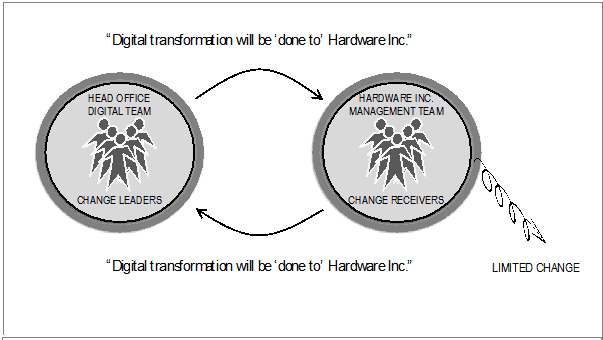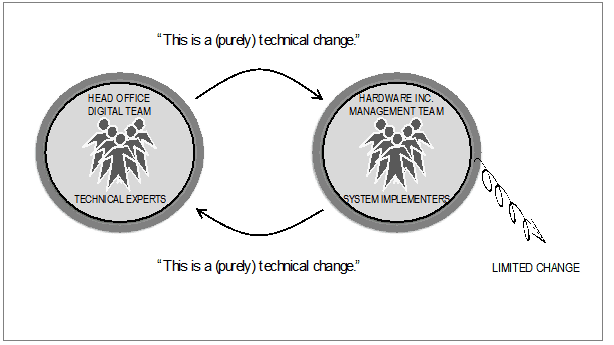“Tim” was the executive in charge of a building hardware company“Hardware Inc.” and was implementing a change to a more consumer-focused culture. As part of this shift, he was undertaking a digital transformation of his business and his vision was clear: “I want our customers to be able to order products online and I need digital tools in place to make doing business easier”. However,Tim was concerned about the remarkably slow progress of his transformation efforts.
Change was happening at a glacial pace
As we sat in my office Tim described the long delay in delivery by the Digital team in Head Office. “I’ve been waiting over 18 months for the online platform and the Digital team in Corporate are working at a snail’s pace! My boss will be bundling me out the door if I can’t get this website delivering bottom-line benefits,quick smart!”
Meanwhile Hardware Inc. was losing ground to its major competitor who had already transformed itself into a lean, mean, digitally-enabled machine.Tim put his head in his hands and said, “Can you please help me to figure out what’s going on with this change?”
I stepped into my detective role to understand what was happening with the transformation efforts at Hardware Inc.Conversations with the Digital team revealed that they had the right skills and capabilities to deliver and had done similar projects in the past. The true nature of this problem seemed to lie elsewhere.I began to examine the ways of relating between the Digital team and Hardware Inc.and discovered two BIG patterns that were preventing this change.
PATTERN 1: Change was being “done to” Hardware Inc.
The first big pattern that was preventing the transformation efforts was that change was being “done to” Hardware Inc. The Digital team members were working on the platform, solutions and tools in isolation,in Head Office. Meanwhile, the managers at Hardware Inc. were sitting back waiting for the change to be delivered. This pattern, that I’ve drawn for you here, was co-created by both parts of the business:

The Digital team members were in role of Change Leaders and the Hardware Inc.team were in role of Change Receivers. This pattern was contributing to the slow pace of change and would need to shift before significant progress would be made with the transformation.
PATTERN 2: This is a (purely) technical change
My detective work revealed a second major pattern in how the Digital team and the Hardware Inc. management team were relating. They had an implicit agreement that this was a(purely)technical change involving building an online platform and delivering digital tools. I’ve drawn this pattern for you here:

The Digital Team members were taking up their role as Technical Experts focused on delivering the digital platform and the Hardware Inc. management team had stepped into the role of System Implementers, holding an assumption that they would “flick the switch” to deploy the solution, with minimal people impacts.
The reality,however, was very different and successful transformation would mean a fundamental rewiring of how Hardware Inc. operated. For instance, in the past the Sales team had helped customers order product, “You want 200 door hinges, 500 handles and 350 fasteners – no problem! I’ve written down your order and will ensure you get these products within a fortnight!”. The digital platform would enable customers to enter and track their own orders, so the role of the Sales team would change from Order Takers to Business Developers. Many Sales Reps were apprehensive about this shift, but Tim and his management team were not identifying these deeply held fears and assumptions that people were holding about the change. Hardware Inc.would need to do business in a very different way in a digital world. The reality was that digital transformation was not a purely “technical” change, but had a human, adaptive component. However, Tim and his management team were not stepping into their Change Leader role to lead and manage the adaptive side of this transition.
Turbo charging the change
Tim and I met at the local café where Itook him through theclues I had gathering about what was going on in Hardware Inc. and the two major patterns that seemed to be preventing progress. He saw the issues immediately, “Ah, so we’ve been waiting for the change to be “done to us” by the Digital team and not managing the adaptive (as well as the technical) side of the transformation”.
“Correct!” I responded. “Digital transformation is not something that can be outsourced to the technical experts. You and your management team must lead and manage the transition to a digitally enabled company.”
What happened next at Hardware Inc?
The management team at Hardware Inc. stepped into its role as Change Leaders and began working side-by-side with the Digital team to deliver the transformation project. The Digital team in turn, shifted into its role as Enabler of the change and began to consult more closely with Hardware Inc. business managers about their requirements.
Tim hired a change expert to help him to redesign the operating model, reframe the roles of the different parts of his business and navigate the adaptive side of the change. For instance, the role of Sales was now framed as “managing a multi-channel business (on-line, sales reps, call center, and branches) in order to deliver revenue growth”. Within three months of our café conversation Hardware Inc. launched its online platform and customers began using the website to order Hardware Inc.products. Seeing and managing the adaptive side of change had been the key to unlocking progress.
What are the implications of the Hardware Inc. story?
Digital transformation has both technical and adaptive components that must be managed in order for the change to be successful. The adaptive side of transformation includes the need to identify the deeply held assumptions about the change and to reframe the roles required in the new world. Tim and his management team faced delays when they saw the transformation as purely technical project that sat in the Digital team in Head Office. Yes, the technical aspects of building the platform were vital but so too were the adaptive components of the change including designing the new operating model for Hardware Inc.Digital transformation invariably has a human element that must be considered and carefully managed if the change efforts are going to be successful.









